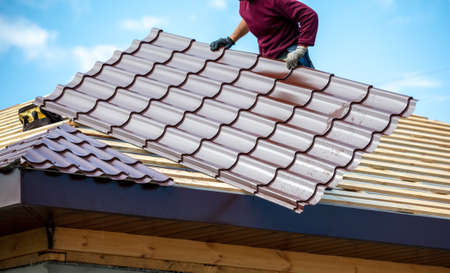1. Spring Roof Inspection and Cleaning
As the weather warms up and winter fades away, its the perfect time for homeowners across the U.S. to give their roofs a thorough inspection. Spring roof maintenance helps catch any damage caused by harsh winter conditions and prepares your home for the upcoming rainy season.
Check for Winter Damage
Start by visually inspecting your roof from the ground using binoculars, or safely climb a ladder if youre comfortable doing so. Look for:
- Missing or cracked shingles
- Loose flashing around chimneys, vents, or skylights
- Sagging areas that may indicate water damage
- Signs of leaks inside your attic or ceiling stains indoors
Remove Debris
Fallen branches, leaves, and other debris can collect on your roof and in gutters during the winter. Clear them out to prevent moisture buildup and potential structural issues.
Look for Moss and Algae Growth
Moss can retain moisture against your roofing materials, leading to premature deterioration. If you spot moss or algae patches, consider using a roof-safe cleaner or contacting a professional for removal.
Clean and Inspect Gutters
Gutters play a key role in directing water away from your home. Clogged gutters can cause water to back up under shingles or overflow near your foundation. Be sure to:
- Remove leaves and twigs from gutters and downspouts
- Check for sagging sections or loose brackets
- Ensure water flows freely through downspouts
Spring Roof Maintenance Checklist
| Task | Description | Recommended Action |
|---|---|---|
| Visual Roof Inspection | Look for damaged shingles and flashing | Replace or repair as needed |
| Debris Removal | Clear branches, leaves, and dirt from roof surface | Use a broom or blower (avoid pressure washers) |
| Moss & Algae Check | Inspect shady areas for moss growth | Treat with appropriate cleaning solution |
| Gutter Cleaning | Clean out gutters and check for blockages | Flush with water and repair loose parts |
Tip:
If youre not comfortable climbing ladders or walking on your roof, consider hiring a licensed roofing contractor to perform the spring inspection safely and thoroughly.
2. Summer Preventive Maintenance
Summer brings dry weather and longer days, making it the ideal time to inspect your roof for any damage that may have occurred during spring storms or winter snow. Taking preventive steps now can save you from costly repairs during peak heat or unexpected summer downpours.
Inspect Your Roof in Dry Conditions
Start by examining your roof on a clear, sunny day when its safe to walk around the property and spot potential issues. Look for signs like cracked shingles, blistering, or areas where shingles are missing entirely.
Common Signs of Roof Wear and Tear
| Sign | Description |
|---|---|
| Cracked Shingles | May indicate sun damage or aging materials. |
| Curling Edges | Often caused by heat exposure or poor attic ventilation. |
| Missing Shingles | Leaves your roof exposed to water infiltration. |
| Moss or Algae Growth | A sign of trapped moisture that can lead to decay. |
Check Flashing and Sealants
Roof flashing—usually found around chimneys, skylights, and vents—helps prevent water leaks. In summer, flashing can expand and contract due to heat, which might cause cracks or loosening. Check these areas for worn-out sealant or rusted metal, and reseal or replace as needed.
Areas to Inspect for Flashing Issues
- Chimney base and corners
- Skylight edges
- Vent pipes and exhaust fans
- Roof-to-wall transitions
Schedule Repairs Before Peak Heat
If you notice any issues during your inspection, try to schedule repairs early in the summer. Roofing professionals often get busy mid-season, especially after major storms. Fixing problems early helps prevent bigger issues like leaks or structural damage as the season progresses.
Pro Tip:
If you live in a region prone to hurricanes or heavy summer rains (like the Southeast), be extra vigilant about scheduling inspections and repairs ahead of storm season.

3. Fall Prep for Winter Conditions
As temperatures begin to drop and leaves start to fall, its time to get your roof ready for the colder months ahead. Prepping your roof in the fall helps prevent costly damage during winter storms and freezing weather. Heres what homeowners across the U.S. should focus on:
Clean Gutters and Downspouts
Falling leaves can quickly clog your gutters and downspouts, leading to water backup that may damage your roof, siding, or foundation. Be sure to:
- Remove leaves, twigs, and debris from gutters.
- Flush out downspouts with a hose to ensure proper drainage.
- Check for sagging or loose gutter sections and repair as needed.
Inspect Shingles and Roof Valleys
Damaged or missing shingles can lead to leaks when snow and ice build up. Roof valleys—where two slopes meet—are especially vulnerable. Take time to:
- Look for cracked, curled, or missing shingles.
- Check roof valleys for debris accumulation or signs of wear.
- Hire a professional if youre unsure about walking on the roof safely.
Ensure Proper Attic Ventilation
A well-ventilated attic helps regulate temperature and moisture levels, reducing the risk of ice dams forming along your roof’s edge. Ice dams can cause water to back up under shingles and leak into your home. To prevent this:
- Inspect soffit vents to make sure they aren’t blocked by insulation or debris.
- Ensure ridge vents are functioning properly.
- Consider adding insulation if your attic feels excessively warm compared to outside temperatures.
Fall Roof Maintenance At-a-Glance
| Task | Why It Matters |
|---|---|
| Clean gutters & downspouts | Prevents water damage and ice buildup |
| Inspect shingles & valleys | Avoids leaks and structural issues during snowstorms |
| Check attic ventilation | Reduces risk of ice dams and improves energy efficiency |
Taking these simple steps in the fall ensures your roof is ready to face whatever winter throws its way—from heavy snow in the Midwest to freezing rain in the Northeast. A little prep now saves major headaches later!
4. Winter Monitoring and Emergency Prep
Winter can be especially tough on your roof, no matter where you live in the U.S. Cold temperatures, snow, and ice can lead to serious roofing issues if not monitored closely. Here are some important steps homeowners should take during the winter months to protect their homes.
Watch for Ice Dams
Ice dams form when heat from your home melts snow on the roof, which then refreezes at the eaves. This can cause water to back up under shingles and leak into your home. Keep an eye out for large icicles or ridges of ice along the edge of your roof—these are signs of possible ice dams. To help prevent them:
- Keep your attic well-insulated and ventilated.
- Use a roof rake to gently remove snow near the eaves (never climb onto a snowy or icy roof).
- Hire professionals for de-icing if buildup gets severe.
Check for Indoor Leaks or Ceiling Stains
Winter weather can reveal hidden roofing problems through indoor symptoms like water stains, peeling paint, or damp spots on ceilings and walls. Perform a quick visual check throughout your home at least once a month during winter. If you notice any of these signs, it might be time to bring in a roofing specialist before the issue worsens.
Manage Snow Buildup Safely
Heavy snow accumulation can put stress on your roof structure, especially flat or low-slope roofs common in northern states. It’s important to monitor snow levels and remove excess snow safely when needed. Here’s a simple comparison of methods:
| Method | Best For | Safety Level | Notes |
|---|---|---|---|
| Roof Rake (from ground) | Light-to-moderate snow | High | Avoids climbing; use with caution around power lines |
| Professional Snow Removal | Heavy snow or hard-to-reach areas | Very High | Recommended for most homeowners; reduces risk of injury or damage |
| Climbing Roof Yourself | Emergency only (not recommended) | Low | Dangerous in icy conditions; always consider professional help first |
Create an Emergency Plan
No one wants to deal with a roofing emergency during a blizzard or freezing rain, but it’s smart to prepare just in case. Keep contact information handy for local roofing contractors who offer emergency services, and make sure your home insurance policy is up to date for winter-related claims.
Quick Tips for Winter Roof Safety:
- Avoid going onto the roof during snow or ice conditions.
- Keep gutters clear before snowfall to reduce ice dam formation.
- If unsure about any condition on your roof, call a licensed roofer.
Taking these precautions during winter helps preserve your roofs integrity and keeps your home safe all season long.
5. Regional Considerations and Climate-Specific Tips
When it comes to roof maintenance, where you live matters—a lot. Different climates across the U.S. bring unique challenges that can affect your roofs condition and lifespan. Tailoring your maintenance routine based on your region helps prevent damage and saves on costly repairs down the road.
Coastal Areas
If you live near the ocean, salty air and high humidity can wear down roofing materials faster than in drier climates. Metal components are especially vulnerable to rust and corrosion.
Maintenance Tips:
- Inspect for rust on metal flashing, nails, and vents every season
- Clean off salt deposits with a gentle water rinse twice a year
- Use corrosion-resistant materials like stainless steel or aluminum when replacing parts
Snowy and Cold Regions
Heavy snow, ice dams, and freeze-thaw cycles can cause serious damage to roofs in colder states.
Maintenance Tips:
- Clear snow buildup regularly using a roof rake to prevent ice dams
- Check attic insulation and ventilation to reduce heat loss that causes melting and refreezing
- Inspect shingles and flashing for cracks or shifting after winter storms
Desert Climates
Hot temperatures and intense UV exposure can dry out roofing materials, causing them to crack or fade prematurely.
Maintenance Tips:
- Inspect for brittle or curled shingles every spring and fall
- Apply UV-protective coatings if recommended for your roofing material
- Check seals around vents and skylights as they may shrink or degrade under extreme heat
Hurricane-Prone Areas
States like Florida, Louisiana, and parts of the Southeast face strong winds, torrential rain, and flying debris during hurricane season.
Maintenance Tips:
- Secure loose shingles, tiles, or flashing before storm season begins
- Trim nearby trees to prevent branches from falling onto the roof
- Install hurricane straps or clips if not already in place to reinforce the roof structure
Quick Reference Table: Roof Maintenance by Region
| Region | Main Challenges | Key Maintenance Tasks |
|---|---|---|
| Coastal Areas | Salt corrosion, high humidity | Rinse salt buildup, inspect for rust, use corrosion-resistant parts |
| Snowy/Cold Regions | Ice dams, snow load, freeze-thaw cycles | Clear snow, check insulation/ventilation, inspect after storms |
| Desert Climates | UV damage, extreme heat | Inspect for cracking/fading, apply UV coating, check seals |
| Hurricane-Prone Areas | High winds, heavy rain, debris impact | Tighten loose components, trim trees, install reinforcements |
No matter where you live in the U.S., understanding your regional climate will help you create a smart seasonal maintenance plan tailored to your home’s specific needs.


